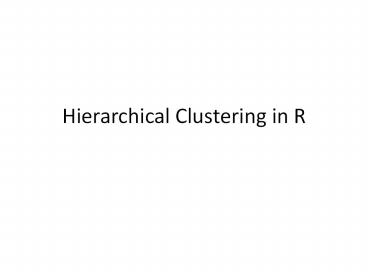Hierarchical Clustering in R PowerPoint PPT Presentation
1 / 11
Title: Hierarchical Clustering in R
1
Hierarchical Clustering in R
2
Quick R Tips
- How to find out what packages are available
- library()
- How to find out what packages are actually
installed locally - (.packages())
3
Hierarchical Clustering
- A type of cluster analysis
- There is both divisive and agglomerative
HCagglomerative is most commonly used - Group objects that are close to one another
based on some distance/similarity metric - Clusters are created and linked based on a metric
that evaluates the cluster-to-cluster distance - Results are displayed as a dendrogram
4
(No Transcript)
5
Step 1 Data matrix
- First you need a numeric matrix
- Typical array data set will have samples as
columns and genes as rows - We want to be sure our data are in the form of an
expression matrix - Use Biobase library/package
- See http//www.bioconductor.org/packages/2.2/bioc/
vignettes/Biobase/inst/doc/ExpressionSetIntroducti
on.pdf - gt exprslt-as.matrix(data, headerTRUE, sep"\t",
row.names1, as.isTRUE)
6
Step 2 Calculate Distance Matrix
- Default dist() method in R uses rows as the
vectors..but we want the distance between
samples.i.e., the columns of our matrix. - There is a handy package to help us at MD
Anderson called oompaBase - source("http//bioinformatics.mdanderson.org/OOMPA
/oompaLite.R") - oompaLite()
- oompainstall(groupName"all")
- Once installed, be sure to locally activate the
libraries - library(oompaBase)
- library(ClassDiscovery)
- library(ClassComparison)
- oompaBase also requires the mclust and cobs
packagesdownload these from CRAN
7
- Use the function distanceMatrix() to create a
distance matrix of your samples. - Uses the expression set created in Step 1 as
input - Remember that there are many different types of
distance metrics to choose from! - See help(distanceMatrix)
- xlt- distanceMatrix(exprs,'pearson')
8
Step 3 Cluster
- Use the hclust() function to create a
hierarchical cluster based on your distance
matrix, x, created in Step 2. - gt ylt-hclust(x,method"complete")
- gt plot(y)
9
Testing for Differential Gene Expression with the
T-test
10
- Get the multtest package from CRAN
- Package contains data from the Golub leukemia
microarray data set (ALL v AML) - 38 arrays
- 27 from lymphoblastic
- 11 from myeloid
http//people.cryst.bbk.ac.uk/wernisch/macourse/
11
- library(multtest)
- data(golub)
- golub.cl
- Generate the T statistic
- teststat lt-mt.teststat(golub, golub.cl)
- Convert into P-values
- rawp0 lt-2pt(abs(teststat),lower.tailF, df38-2)
- Correct for multiple testing and show the ten
most significant genes - procs lt-c(Bonferroni, BH)
- reslt-mt.rawp2adjp((rawp0), procs)
- resadjp110,
http//people.cryst.bbk.ac.uk/wernisch/macourse/

